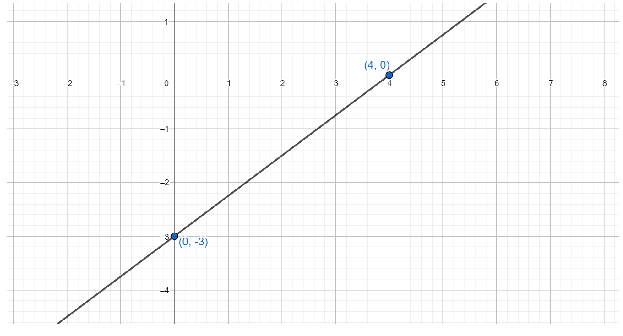
How do you graph
Answer
468.9k+ views
Hint:To draw a graph, we need at least two points which lie on the given line. We can find the two intercepts of the line and use them as the two coordinates to draw that line.
As we know that the two kinds of intercepts are
So, to calculate the intercepts, we will put
Complete step by step solution:
(i)
We are given the line equation:
As we are asked to draw the graph of
Now, as we know that
Therefore, the
(ii)
Similar to
Therefore, the
(iii)
Now, to draw a graph we need two points which lie on the line. As we have calculated both the intercepts, we can say that the line crosses the
Similarly, the line crosses the
Marking these two points on a graph and then joining the points through a line will give us the graphical representation of the line

Hence, this is the line
Additional Information: A line parallel to
Note: In an equation of the form
Also, there is an alternative method to find the intercepts of a line equation. Convert the given line equation into intercept form of a line i.e.,
As we know that the two kinds of intercepts are
So, to calculate the intercepts, we will put
Complete step by step solution:
(i)
We are given the line equation:
As we are asked to draw the graph of
Now, as we know that
Therefore, the
(ii)
Similar to
Therefore, the
(iii)
Now, to draw a graph we need two points which lie on the line. As we have calculated both the intercepts, we can say that the line crosses the
Similarly, the line crosses the
Marking these two points on a graph and then joining the points through a line will give us the graphical representation of the line

Hence, this is the line
Additional Information: A line parallel to
Note: In an equation of the form
Also, there is an alternative method to find the intercepts of a line equation. Convert the given line equation into intercept form of a line i.e.,
Recently Updated Pages
Master Class 9 General Knowledge: Engaging Questions & Answers for Success

Master Class 9 English: Engaging Questions & Answers for Success

Master Class 9 Science: Engaging Questions & Answers for Success

Master Class 9 Social Science: Engaging Questions & Answers for Success

Master Class 9 Maths: Engaging Questions & Answers for Success

Class 9 Question and Answer - Your Ultimate Solutions Guide

Trending doubts
State and prove Bernoullis theorem class 11 physics CBSE

What are Quantum numbers Explain the quantum number class 11 chemistry CBSE

Who built the Grand Trunk Road AChandragupta Maurya class 11 social science CBSE

1 ton equals to A 100 kg B 1000 kg C 10 kg D 10000 class 11 physics CBSE

State the laws of reflection of light

One Metric ton is equal to kg A 10000 B 1000 C 100 class 11 physics CBSE




